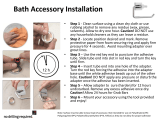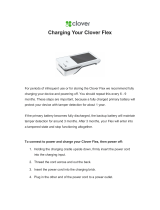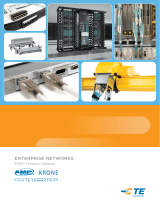Page is loading ...

OPERATION AND SAFETY MANUAL
Warranty
Jameson products carry a warranty against any defect in material and workmanship for a period of one year from date of shipment unless failure is due to
misuse or improper application. Jameson shall in no event be responsible or liable for modications, alterations, misapplications or repairs made to its products
by purchaser or others. This warranty is limited to repair or replacement of the product and does not include reimbursement for shipping or other expenses
incurred. Jameson disclaims any other express or implied warranty.
Part Number Rod Diameter X Length
16-14-300M 1/4” X 300’
16-14-400M 1/4” X 400’
16-14-500M 1/4” X 500’
16-14-600M 1/4” X 600’
• DO NOT USE ON LIVE CIRCUITS. DISCONNECT POWER. Metal tip on rod.
• Wear safety glasses and gloves.
• Keep rod inside reel when not in use. Out-of-control rod can harm personnel or property.
• Keep rod clean. Some contaminants (including water) can conduct electricity.
• Keep secure footing. Protect yourself from falling should pulling eye move suddenly or separate from rod.
• Check for rod damage prior to use. Cracks, gouges, nicks, or white stress marks on jacket or sharp bends will weaken rod.
Injury could result if rod breaks while pulling.
• Do not use slip joint pliers, locking pliers or powered pulling equipment on rod.
• Do not force a pull that is stuck. Remove wires and check for kinks or obstructions.
• Avoid pulling rod over sharp edges.
• Do not bend rod beyond 4” radius.
WARNING - ADHESIVE
Read manufacturer’s instructions before using adhesive. In case of eye contact, ush with water and seek medical atten-
tion If skin contact occurs, apply solvent (such as nail polish remover) to area and gently remove adhesive. Wash solvent
off with water. Solvents should not be used in case of contact with eyes or open wounds.
Always wear safety goggles (ANSI Std. Z87.1) and gloves when working with adhesive and/or unprotected berglass rod.
See adhesive product label for Safety Data Sheet (SDS).
Accessories
16-14-AK Accessory Kit
Roller Guide, End Ferrule, Splice Ferrule,
2 Adhesive, 2 Emery Cloth, Canvas Pouch
16-169 Flexible Spring Tip
Heavy duty spring attached to ball nose helps push
rod past difcult bends or debris in pipe
16-160 Swivel Eye Attaches pull line to rod
16-146 End Ferrule Kit End Ferrule, Adhesive, Emery Cloth
16-140 Splice Kit Splice Ferrule, Adhesive, Emery Cloth
End Ferrule
Splice Ferrule
Adhesive
Roller Guide With
Spring Adapter
Flexible Spring Tip
Accessory Kit Included. Other Accessories Sold Separately.
Jacket Core Wire

1. Set drag brake to highest amount of drag.
2. Insert end of rod between safety roller guides. This ensures rod is safely contained while working with it.
3. Release pressure on drag brake handle so rod will begin to slowly payout from reel.
4. Brake may be set for constant drag on payout of rod. Constant drag makes one-man operation possible.
Fully tightening brake stops rod payout. For constant drag and controlled payout, set brake handle where reel
turns only as rod is pulled.
5. Pay out rod into underground facility. Lock brake handle.
6. Attach signal output lead from transmitter to nut on clip attachment. Attach ground lead to desired ground
mechanism.
7. Follow transmitter’s operating instructions to apply desired signal frequency to rod.*
8. Use receiver to trace path of rod following instructions of receiver.
9. If further rod payout is required, detach transmitter output lead, loosen drag brake and pay out more rod.
Lock brake handle and re-attach transmitter output lead.
10. When recoiling rod, detach transmitter lead, loosen drag brake and push rod back onto reel. Allow reel to
spin only when pushing rod. Do not manually spin reel in an attempt to reel up rod.
* Always follow the manufacturer’s instructions and precautions when using your transmitter and receiver.
Jameson is not responsible for damage or injury as a result of improper use of your transmitter or receiver.
Drag Brake
Roller Guides
Clip Attachment
Using The Duct Hunter
Use With Transmitter and Receiver. Not Included With Duct Hunter.
800.346.1956 www.SpartacoGroup.com Clover, SC

In rare instances, a buried utility is difcult to locate for reasons such as extreme depth of pipe, extreme
length of pipe, material of pipe, extremely dry soil, outdated locating equipment, crowded surrounding
utilities, common utility grounds, etc. Jameson Traceable Rodders are not guaranteed to solve every
conceivable locating challenge. The experience of the user plays the largest role in achieving a
successful locate.
If the user cannot locate the rod signal, perform the following checks:
1. Verify transmitter and receiver have batteries installed with adequate charge level.
2. Verify transmitter and receiver are set to matching frequencies.
3. Once conrmed, follow either test method below to inspect for a defect in the rod or ferrule:
Test Method 1 (preferred): Use a digital multi-meter to check continuity from the hook-up point on the
reel of the Duct Hunter to the tip end ferrule. If the continuity is good (usually less than 30 Ohms,) the DH
is functioning properly.
Test Method 2: If a multi-meter is not available, perform an alternate continuity test instead. Pay out
75-100 feet of rod and make a large loop on the ground. Connect the red clip of your transmitter to
the contact lug on the reel, and the black clip to the tip end ferrule. Attempt to trace the rod with the
receiver. If it traces, the DH is functioning properly.
Note: The Duct Hunter has a continuous copper wire. Failures in the eld are usually due to locating
equipment error, inexperience, or extreme environments. Tests in Step 3 will indicate if a legitimate de-
fect is present, such as the ferrule on the hook-up point on the reel becomes loose and fails to contact
the copper wire inside the rod.
4. If Test Methods 1 and/or 2 fail, replace the end ferrule and re-test.
5. If Test Methods 1 and/or 2 pass, you may want to:
a. Use the highest frequency available on the transmitter
b. Use the highest power setting on the transmitter, and choose a frequency below 45 kHz.
c. Improve the depth of the ground spike, and/or pour water around the ground spike.
Troubleshooting Tips: Traceable Rodder Operation
800.346.1956 www.SpartacoGroup.com Clover, SC

DH1614_MO3
Splice Repair
End Ferrule Repair
Fig. 1
Fig. 2
Red Jacket
Fiberglass Core
Fold Wire Back
Along Flat Portion
1”
Red Jacket
Fiberglass Core
Copper Wire
1”
1”
1. Cut away damaged section(s) of rod with a ne-tooth hacksaw,
cable cutter or sharp knife. With pipe cutter and/or sharp knife, strip red
protective jacket back from berglass core approximately 2”. Do not
cut berglass core when stripping jacket. Do not crush berglass core.
2. Once jacket is removed, use pipe cutter again to score a mark
around berglass core approximately 1” from edge of jacket. Use sharp
knife to carefully strip away 1” of berglass core closest to rod end to
expose copper wire. Be careful not to damage wire. The 1” portion of
rod closest to jacket will remain intact (Fig.1).
3. Using sharp knife, strip away a at spot on remaining 1” portion of
berglass core approximately as deep as wire diameter (.04”). Cut ex-
posed wire length to approximately 1” and lightly strip away thin coat-
ing on copper wire. Fold wire back along at spot in berglass core (Fig.
2).
4. Attempt a test t of replacement ferrule over exposed berglass core
with wire folded back. It should be rm and snug with little or no play
to assure wire contacts inside of ferrule. If too loose, cut away rod end
and repeat Steps 1-4.
5. Once proper t is established, install end ferrule without adhesive and
check for continuity of the internal copper wire using a digital multi-
meter. Touch a probe to end ferrule at each end of coiled rod. Any
resistance reading (generally between 2-12 ohms) indicates proper
continuity.
6. Remove end ferrule. Clean rod end and ferrule with cleaning
solvent or alcohol to remove debris and glass bers. Allow solvent to
completely evaporate. Step 6 is extremely important.
7. Mix and apply adhesive to entire surface of berglass core and wire.
Insert rod into ferrule as far as possible, enclosing end of red jacket in
counterbore of ferrule. Wipe away excess adhesive.
8. Check rod again for continuity using digital multimeter. The adhesive
will not set for 20 minutes. If no continuity, remove ferrule, clean off ad-
hesive and repeat steps 1-7.
Splicing: Follow steps 1-8 for both ends of rod being spliced. Use
splice ferrule instead of end ferrule. Before inserting prepared rod
ends into splice ferrule, slide piece of heat shrink tubing over one rod
end and move it along rod out of way.
Once a proper splice is obtained, wait at least 20 minutes for ad-
hesive to set. Move heat shrink tubing over splice ferrule so it is
completely covered. Use heat gun or blow torch to carefully shrink
tubing, starting in center and working toward each end. Wipe away
any adhesive that oozes from the heat shrink tubing.
Repaired or spliced rod should be allowed to cure 24 hours prior to use.
Splicing Rod Or Attaching New End Ferrule
www.SpartacoGroup.com
Clover, SC
/



